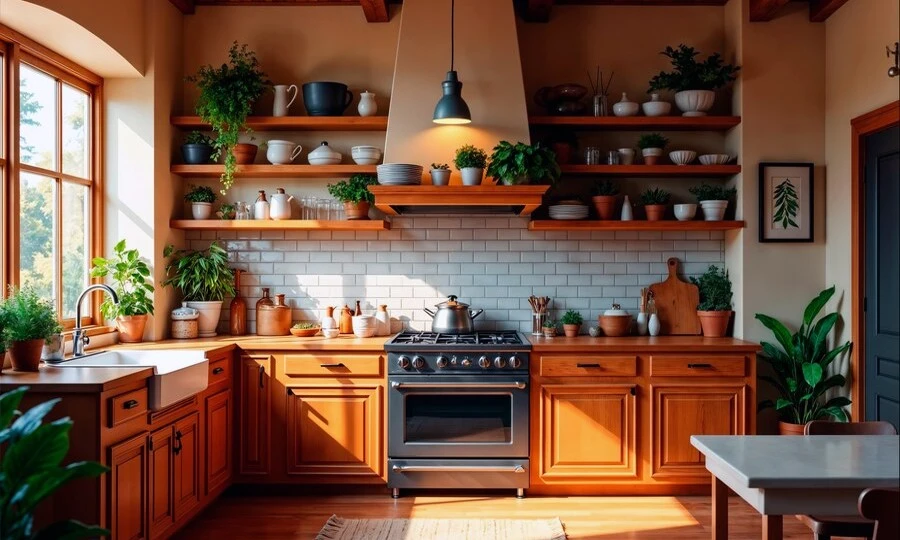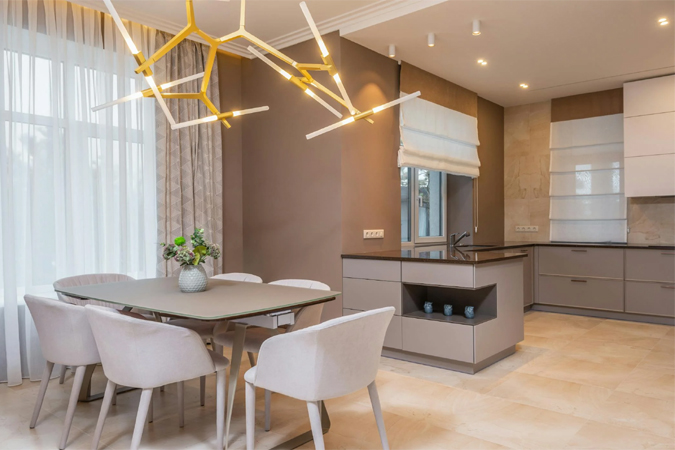An Arts and Crafts style kitchen celebrates craftsmanship and natural materials. It reflects the beauty of simple design and functionality.
The Arts and Crafts kitchen style dates back to the late 1800s. It began as a pushback against the rise of industrial mass production. People wanted more handcrafted, high-quality pieces in their homes.
Today, this timeless kitchen design brings warmth and comfort to any home. An Arts and Crafts kitchen features rich wood cabinets, sturdy furniture, and beautiful handcrafted details. You’ll often see earthy colors and natural textures that create a cozy, welcoming vibe. It’s a space that feels both practical and personal—perfect for everyday living and entertaining. This design isn’t just about looks; it’s about function, too. Every element has a purpose, blending charm with usability.
Thinking about upgrading your kitchen? Discover how the Arts and Crafts kitchen style can turn your space into a warm, inviting retreat. It’s a classic look that never goes out of style.
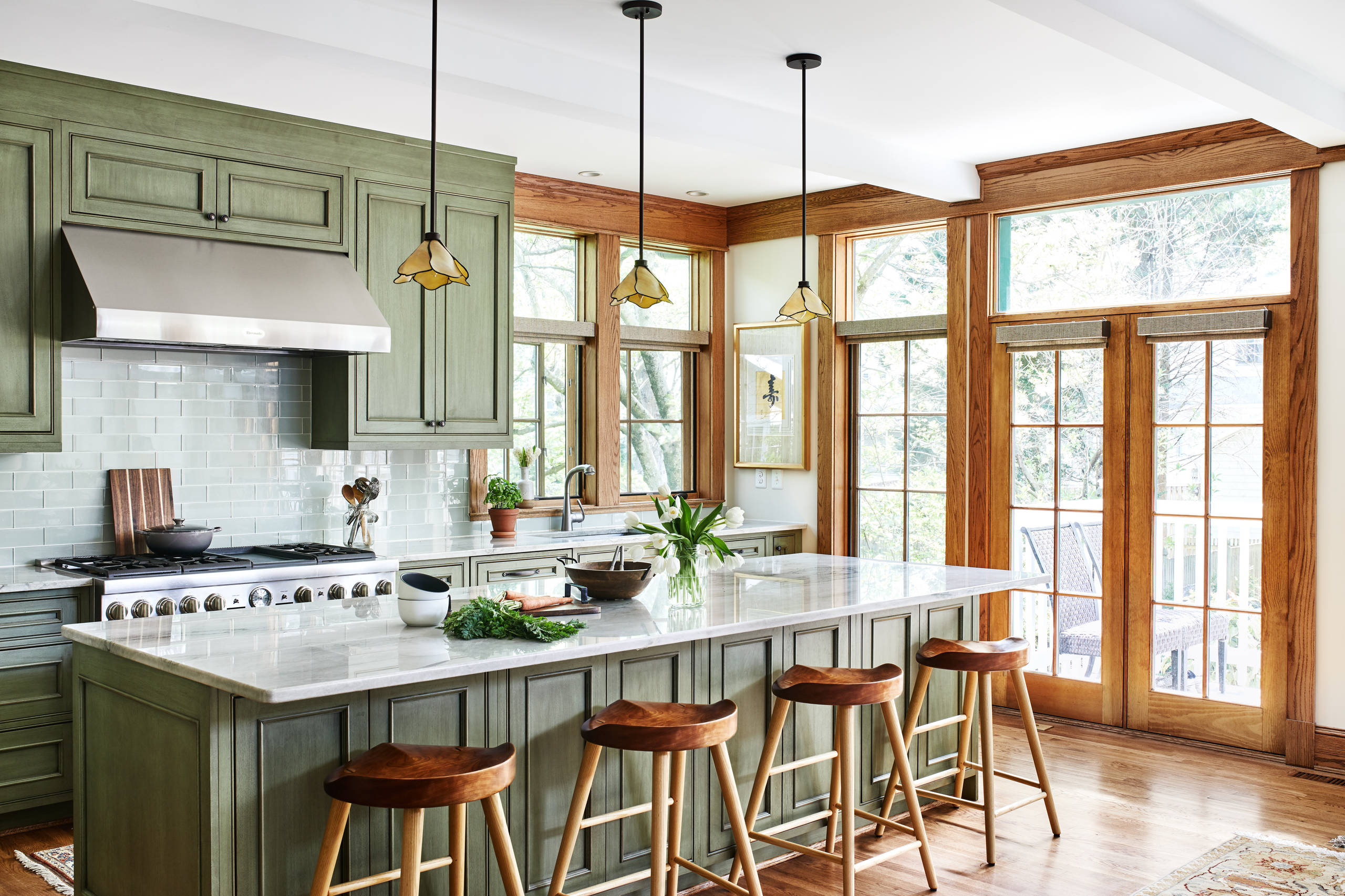
Credit: www.houzz.com
Introduction To Arts And Crafts Style
The Arts and Crafts style is more than just a look. It celebrates handmade work, simple design, and natural beauty. Picture a kitchen that does more than cook meals—it tells a story. It reflects the charm of early 1900s design. In this space, you’ll see real wood, handcrafted touches, and honest, thoughtful details. It feels warm, cozy, and full of character. When you walk in, it’s like stepping into a piece of history.
Origins And History
The Arts and Crafts movement started in the late 1800s in England. It was a reaction to the rise of factories and cheap, mass-produced goods. Designers like William Morris believed in bringing back quality and care through handmade work. They wanted to celebrate the skill of artisans and the joy of creating things by hand.
When the movement came to America, it took off. Designers like Frank Lloyd Wright and Gustav Stickley helped spread its ideas. They used the style in homes and buildings across the country. In the U.S., the Arts and Crafts style became known for simple, functional designs that felt natural and honest.
Key Characteristics
Arts and Crafts kitchens stand out for their use of natural materials. You’ll often see real wood, stone, and metal—each picked for its honest, natural beauty. This style avoids fake or plastic materials, focusing instead on the warmth and texture of the real thing.
The design is simple and clean. Cabinets usually have solid wood doors with classic, easy-to-use hardware. There’s no extra decoration—just strong, beautiful materials that speak for themselves.
The colors are calm and earthy. Think warm browns, deep greens, and soft creams. These shades help create a peaceful, cozy space that feels close to nature.
But it’s not just about looks. An Arts and Crafts kitchen works hard, too. It’s built for real life—cooking, gathering, and slowing down. It reminds you to value handmade things and thoughtful design. Maybe it’s time to see your kitchen not just as a place to cook, but as a space for comfort and creativity.
Incorporating Natural Materials
Give your kitchen a fresh, timeless look with the Arts and Crafts style. This design highlights natural materials like wood and stone, creating a warm, welcoming space full of rustic charm. It’s all about keeping things simple and letting quality craftsmanship shine.
Bringing nature into your kitchen starts with the materials you choose. Wood, stone, and other natural textures add warmth and character. This style honors the beauty of handmade details and thoughtful design. The result? A kitchen that feels calm, cozy, and truly one of a kind.
By embracing the Arts and Crafts kitchen style, you can turn your cooking space into a peaceful retreat that blends style and comfort.
Wood Selections
Wood plays a starring role in Arts and Crafts kitchens. Choosing the right type of wood can make a significant difference. Oak, cherry, and maple are popular choices due to their durability and rich textures. Each type of wood offers a distinct personality, from oak’s robust grain to cherry’s warm hues. Consider your kitchen’s lighting when selecting wood, as natural light can enhance the wood’s natural beauty. The finish you choose also impacts the overall feel. A matte finish can give a rustic touch, while a polished finish offers elegance. Think about how you use your kitchen. Do you lean towards a more lived-in look, or do you prefer a pristine appearance? Your choice of wood and finish can reflect your lifestyle and preferences.
Stone And Tile Options
Stone and tile are excellent complements to wood in an Arts and Crafts kitchen. They add a touch of elegance and durability to work surfaces and backsplashes. Consider using materials like slate or limestone, which provide texture and depth. Each piece of stone is unique, adding character to your kitchen. Tiles offer a chance to introduce color and pattern. Handcrafted tiles can be a beautiful focal point, providing a splash of creativity. Imagine a mosaic backsplash that tells a story or geometric patterns that draw the eye. How do you want your kitchen to feel? Tiles can be a powerful tool to express your personal style. Embrace the imperfections of natural materials. They tell a story and bring authenticity to your space. Which natural elements speak to you? Let them guide your choices and create a kitchen that’s truly your own.
Color Palette Choices
The Arts and Crafts style kitchen embodies warmth and nature. Choosing the right color palette is crucial. It sets the tone and enhances the charm. Earth tones and warm colors create a cozy ambiance. Accent and contrast colors add depth and interest. Each element contributes to a harmonious design.
Earth Tones And Warm Colors
Earth tones are perfect for an Arts and Crafts kitchen. They bring a sense of calm and groundedness. Shades like olive, brown, and terracotta evoke nature. These colors complement wooden cabinets and stone countertops. Warm colors, such as mustard yellow or burnt orange, add vibrancy. They create a welcoming atmosphere. Mixing these shades makes the kitchen inviting and serene.
Accent And Contrast Colors
Accent colors bring personality to your kitchen. Shades like deep green or navy blue can make a bold statement. They stand out beautifully against warm, earthy tones. Try using them on cabinets, tiles, or even a kitchen island.
These contrast colors help highlight special details, like woodwork or built-in features. You don’t need a lot—just a touch of burgundy, teal, or another rich color can add depth and style. Used wisely, bold accents enhance the charm of your Arts and Crafts kitchen without overwhelming the space.
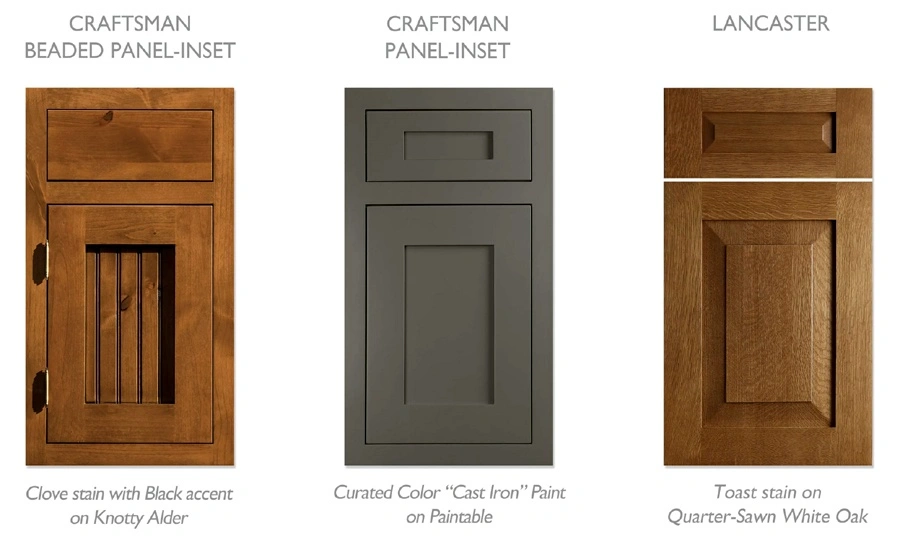
Credit: www.durasupreme.com
Cabinetry And Storage Solutions
Arts and Crafts kitchens are known for their beautiful cabinetry and smart storage. You’ll often see natural wood, clean lines, and fine craftsmanship—all working together to create a warm, welcoming space.
To bring this style into your home, focus on the details. Well-built cabinets and practical storage are key. This design isn’t just about looks—it’s about function, too. Whether you’re remodeling or starting fresh, choosing quality materials and simple, thoughtful layouts can help you build a kitchen that feels both stylish and easy to use.
Custom Woodwork
Custom woodwork plays a crucial role in achieving the Arts and Crafts look in your kitchen. Imagine cabinets crafted from rich oak or cherry, each piece telling its own story. These materials not only add warmth but also bring a timeless elegance to your space. Consider the details—like intricate carvings or simple, yet bold designs. You can personalize the woodwork to match your taste and lifestyle. When I renovated my kitchen, choosing custom woodwork was like writing a chapter of my home’s history. It felt personal and unique. But here’s a question: How do you envision your kitchen telling your story through woodwork?
Built-in Storage Ideas
Built-in storage is key to keeping the clean, simple look of an Arts and Crafts kitchen. It helps you save space without losing style. Make the most of every inch—under the stairs, above the sink, or even that tricky corner you’ve never used.
In my own kitchen, I added shelves above the counter. It was a simple change, but it made a big difference. Everyday items are now easy to reach, and the space feels tidy and calm. Cooking became more fun and less stressful.
Smart storage not only keeps things neat—it also adds to the kitchen’s charm. With custom woodwork and built-in solutions, you can create a kitchen that’s beautiful, organized, and fits your daily life. Think about your own space—where could a built-in shelf or cabinet make things easier? The Arts and Crafts style gives you the tools to design a kitchen that’s both personal and practical.
Lighting Fixtures And Effects
Warm, inviting lighting is a key part of an Arts and Crafts kitchen. Soft light brings out the natural beauty of wood and highlights handcrafted details. Pendant lights and wall sconces add charm while creating a cozy, welcoming feel.
The right lighting can turn your kitchen from simple to stunning. It’s more than just brightness—it sets the mood and shows off the unique features of your space. Whether it’s soft overhead lighting or focused task lights, each fixture plays a role in making your kitchen feel warm, relaxing, and full of character.
Ambient Lighting Options
Ambient lighting is the base of your kitchen’s lighting design. It provides the overall light you need to move around safely and comfortably. To match the Arts and Crafts style, consider stained glass pendant lights or lantern-style fixtures. These types of lights help tie the look together while adding charm.
When choosing lighting, think about where to place your fixtures. Ceiling lights can spread light evenly across the room, making the space bright and welcoming. This approach not only lights up the kitchen but also highlights the rich wood tones and craftsmanship that define the style.
Don’t forget about dimmers—they’re a game changer! With a dimmer switch, you can adjust the light depending on the time of day or your mood. A well-placed dimmer makes your kitchen feel cozy and intimate, perfect for quiet evenings.
Task Lighting Ideas
Task lighting is essential for specific activities like chopping vegetables or reading recipes. It should be bright and focused. Under-cabinet lighting is a popular choice. It’s practical and unobtrusive, helping you see clearly without casting shadows. Consider adjustable arm wall lamps or counter-top lamps. These can add a touch of character to your kitchen while providing the light you need for various tasks. Have you ever struggled to find the right spice in a dimly lit pantry? Adding a small, bright light in your pantry or inside cabinets can save time and reduce frustration. It’s these small details that make a big difference in the functionality of your kitchen. What lighting solutions have you found most effective in your own kitchen? Your experiences could inspire others to enhance their Arts and Crafts style kitchen.
Decorative Elements And Accessories
The Arts and Crafts style kitchen is all about celebrating craftsmanship and individuality through decorative elements and accessories. These kitchens are designed to be warm and inviting, with every piece telling a story. Whether you’re crafting meals or just enjoying the space, the details in this kitchen style create an ambiance like no other. What makes an Arts and Crafts kitchen truly unique are its handcrafted details and functional art pieces that seamlessly blend beauty with practicality.
Handcrafted Details
Handcrafted details are the heart of an Arts and Crafts kitchen. Picture the intricate woodwork on your cabinets, with every curve showcasing the artisan’s skill. It’s not just about looks—these details bring depth and character to your kitchen, making it feel personal and full of warmth.
Consider adding hand-painted tiles to your kitchen backsplash. With nature-inspired designs or geometric patterns, they perfectly match the Arts and Crafts style. These tiles not only protect your walls but also create a visual delight, drawing compliments from anyone who enters.
Do you have a cherished memory tied to a handcrafted item? These details can stir up those feelings, turning your kitchen into a place filled with stories and sentimental value. Handcrafted elements are more than just decor—they are memories waiting to be made.
Functional Art Pieces
Functional art pieces blend the beauty of Arts and Crafts with everyday use. Imagine a stained-glass cabinet door that not only holds your dishes but also adds color and light to the space. It turns a simple task, like grabbing a plate, into a beautiful experience.
You can also bring in pottery and ceramics as both functional and decorative elements. Handmade mugs and bowls displayed on open shelves add warmth and texture to your kitchen. Each piece is one-of-a-kind, making every use a little surprise.
Have you ever thought about how functional art could inspire your cooking? A beautifully crafted utensil holder or cutting board can make even the most basic tasks feel special. These pieces elevate your kitchen, turning it into a more enjoyable and engaging space.
As you explore these decorative touches, ask yourself: What story do you want your kitchen to tell? Arts and Crafts style invites you to express your personality and make your kitchen truly yours.
Flooring Options For Durability
Enhance your Arts and Crafts style kitchen with durable flooring options. Choose hardwood or stone for a timeless look that’s built to last. These materials not only match the style but also stand up to daily use.
Creating an Arts and Crafts kitchen isn’t just about selecting the right cabinets and decor; the flooring plays a key role in setting the tone. A well-chosen floor can handle the wear and tear of everyday kitchen life while complementing the overall design. Let’s explore flooring options that combine durability with style.
Wood And Tile Choices
Wood floors bring warmth and authenticity to an Arts and Crafts kitchen. Opt for hardwoods like oak or cherry, which are not only durable but also age beautifully. These options can withstand spills and scratches, making them ideal for a busy kitchen. Tile is another excellent choice, offering a wide range of colors and patterns. Ceramic or porcelain tiles are known for their resilience and ease of maintenance. They can mimic the look of natural stone, adding a rustic charm to the kitchen floor.
Rug And Mat Suggestions
Adding a rug or mat can enhance comfort and style in your kitchen. Look for rugs made of materials like wool or cotton, which are soft underfoot and easy to clean. A well-placed rug can also protect high-traffic areas from wear and tear. Think about where you spend the most time standing, such as in front of the sink or stove. Placing a cushioned mat in these areas can reduce fatigue and provide extra support. Choose patterns and colors that reflect the Arts and Crafts aesthetic, adding a cohesive look to your space. Choosing the right flooring involves balancing practicality with style. Have you considered how your flooring choice will interact with your kitchen’s lighting and cabinetry? Each element should work together to create a harmonious and functional environment.
Modern Adaptations And Innovations
Modern updates to the Arts and Crafts kitchen blend traditional charm with fresh, innovative design. Natural materials like wood and stone, combined with simple lines, create a cozy and inviting atmosphere. Custom woodwork and handcrafted tiles add unique touches, making this timeless style feel personal and special.
Today’s Arts and Crafts kitchens mix the best of both worlds. While the style still emphasizes craftsmanship and simplicity, it now includes modern elements to fit today’s needs. As you explore these kitchens, you’ll see how the old meets the new, creating a space that blends timeless appeal with modern convenience.
Blending Old And New
During my own kitchen renovation, I found that blending old and new elements creates something truly special. I kept the classic wooden cabinets but added sleek, stainless steel appliances. This mix brought a fresh, dynamic feel to the space, making it cozy yet modern.
You might want to try adding open shelving with vintage dishware alongside modern lighting fixtures. This mix honors the traditional Arts and Crafts style while bringing in a trendy touch. How could you combine different styles in your kitchen to make it unique and personal?
Eco-friendly Enhancements
Sustainability is important in today’s kitchen designs, including Arts and Crafts style. Choose materials like reclaimed wood or bamboo for your cabinets to help the environment. These choices keep the style’s beauty while being eco-friendly.
Energy-efficient appliances are another great option. They save energy and fit well with the design. Have you thought about how your kitchen can be stylish and sustainable? You can add natural light by installing windows or skylights, making the space bright without using too much electricity.
What steps can you take to make your kitchen more eco-friendly? By blending traditional and modern choices, you can create an Arts and Crafts kitchen that’s beautiful and good for the planet.
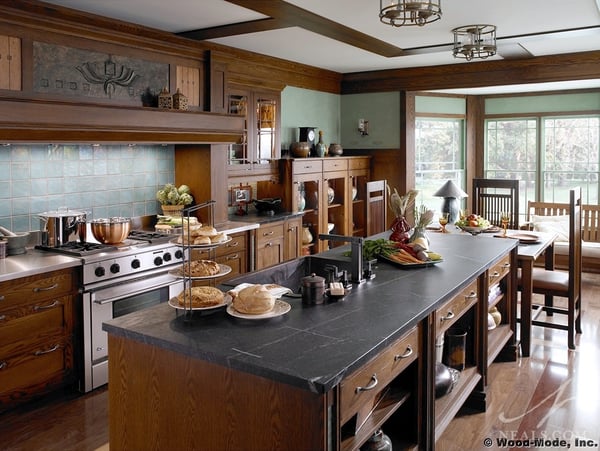
Credit: info.neals.com
Frequently Asked Questions
What Style Is Arts And Crafts?
The Arts and Crafts style focuses on handcrafted work, simplicity, and natural materials. It showcases clean lines, earthy colors, and detailed craftsmanship. This style values quality over mass production, creating designs that are both functional and beautiful. Common features include wood, ceramics, and stained glass, often inspired by nature.
It combines beauty with practicality.
What Are The Colors For Arts And Craft Kitchens?
Arts and crafts kitchens feature earthy tones like greens, browns, and creams. Rich, warm shades such as deep reds and golds are also common. These colors create a cozy and inviting atmosphere, reflecting the natural world.
Is $10,000 Enough For A Kitchen Remodel?
With a $10,000 budget, you can do a minor kitchen remodel. Focus on painting, updating fixtures, and refinishing cabinets. Avoid major changes like new appliances or countertops. Costs may vary depending on your location and materials, so plan carefully. Prioritize key upgrades to get the most value and improve functionality.
Always compare prices for materials and labor.
What Is The Difference Between Arts And Crafts And Craftsman Style House?
Arts and Crafts style emphasizes handcrafted details and natural materials. Craftsman style, a type of Arts and Crafts, focuses on simplicity, practicality, and fine woodwork. Both styles value quality craftsmanship, but they differ in architectural details and design focus.
Conclusion
An Arts and Crafts style kitchen brings charm and warmth. This design focuses on natural materials and craftsmanship. It values simplicity and functionality. Every element adds authenticity and comfort. Choose wood cabinets, stone countertops, handcrafted tiles, and stained glass.
These details give the kitchen unique character. An Arts and Crafts kitchen feels inviting and timeless, with a cozy, lived-in vibe. It’s perfect for family meals and gatherings. This style blends tradition with modern living. Embrace it for a kitchen full of personality and life.
It truly transforms the heart of your home.

